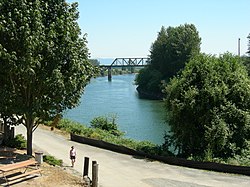| Snohomish River | |
|---|---|
 Snohomish River in Snohomish, Washington | |
 Map of the Snohomish River and tributaries | |
| Location | |
| Country | United States |
| State | Washington |
| County | Snohomish |
| Physical characteristics | |
| Source | Confluence of the Skykomish River and the Snoqualmie River |
| • location | Monroe |
| • coordinates | 47°49′48″N122°2′47″W / 47.83000°N 122.04639°W [1] |
| Mouth | Puget Sound |
• location | Port Gardner |
• coordinates | 48°1′16″N122°12′30″W / 48.02111°N 122.20833°W [1] |
• elevation | 0 m (0 ft) |
| Length | 20 mi (32 km) [2] |
| Basin size | 1,856 sq mi (4,810 km2) [3] |
| Discharge | |
| • location | Near Monroe [4] |
| • average | 9,511 cu ft/s (269.3 m3/s) [4] |
| • minimum | 763 cu ft/s (21.6 m3/s) |
| • maximum | 150,000 cu ft/s (4,200 m3/s) |
The Snohomish River is a river in Snohomish County, Washington, formed by the confluence of the Skykomish and Snoqualmie rivers near Monroe. It flows northwest entering Port Gardner Bay, part of Puget Sound, between Everett and Marysville. The Pilchuck River is its main tributary and joins the river at Snohomish. The river system drains the west side of the Cascade Mountains from Snoqualmie Pass to north of Stevens Pass.
Contents
Measured at Monroe, the Snohomish River has an average annual flow of 9,500 cubic feet per second (270 m3/s). [2] In comparison, the Columbia River, Washington's largest river, has an average flow of about 265,000 cubic feet per second (7,500 m3/s). [5]




